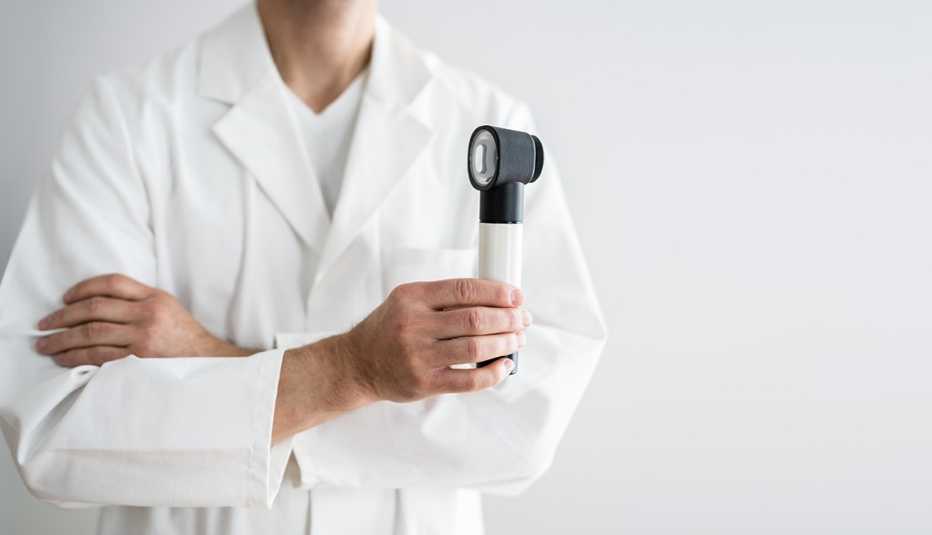AARP Hearing Center


That warm sun can feel so good, but decades of soaking up the rays can lead to unfortunate results: brown spots, wrinkles, broken capillaries, uneven skin texture, freckles — and skin cancer. In fact, one-fifth of U.S. adults will get skin cancer by the age of 70, yet a 2024 survey by AARP shows that only 37 percent of adults use sunscreen regularly.
Wearing sunscreen daily plays a big role in protecting your skin, but there are plenty of other ways to keep it healthy while you enjoy the sun. To help you, this AARP Smart Guide to Sun Protection includes an SPF primer, advice on finding the products that will work best for your skin tone and type, and pointers on topics to discuss with your dermatologist at your next annual exam.


SKIN HEALTH BASICS
1. Visit your dermatologist regularly
Just like your annual physical or eye exam, you should schedule an annual skin check with your dermatologist for skin cancer prevention (or more frequently, if necessary, based on your skin health history). The doctor will also examine your skin for sun damage, which they may refer to as photoaging, photodamage or solar damage. “During these appointments, your dermatologist will check your skin for any unusual lesions that require medical attention,” says Sumayah Jamal, M.D., a dermatologist with the Schweiger Dermatology Group in New York City. Early detection is key for catching skin cancer, and these screenings allow a physician to check every inch of your skin for moles, rashes and any changes from year to year. You should also do monthly skin checks at home.
2. Be prepared for your appointment
Arrive at your appointment with your hair loose and no nail polish. If you’re wearing makeup, take a makeup wipe to remove it. In between appointments, take photos of any suspicious spots to show your doctor. “You’re just looking for something that’s new or unexpected or a change that you don’t think is right for your skin,” says Karen Stolman, M.D., a board-certified dermatologist with Park City Dermatology in Utah and a spokesperson for the Skin Cancer Foundation.
When melanoma is detected early, the five-year survival rate is 99 percent, according to the American Academy of Dermatology. If you are researching photos of skin cancer, keep in mind that it can look very different based on your skin tone. The American Cancer Society says that if you notice your skin has a rough patch that crusts, bleeds, oozes or causes pain, or if you’ve developed a mole or spot that changes in size, shape or color, you should visit your dermatologist as soon as possible — even if it falls between your annual checkups.
3. Know what to look for
Skin cancer — the abnormal growth of skin cells — is the most common cancer in the United States and worldwide, according to the Skin Cancer Foundation. This umbrella term encompasses many types of cancers, and treatment can involve surgery to remove the cancerous cells.
Skin cancer is an increasing concern as we age, Stolman says. Precancerous skin growths, also known as actinic keratoses, are common and can be the result of sun damage that began 10 to 20 years ago and has built up over time. Some actinic keratoses can develop into squamous cell skin cancer (see below). In addition, says Stolman, “with age, our immune system becomes less capable of protecting us from all forms of cancer, including skin cancer.” There are three major types of skin cancer:
- Basal cell carcinoma (BCC), the most common type of skin cancer, occurs when UV radiation triggers skin cells to grow uncontrolled. A nonmelanoma, BCC can range widely in appearance and present as open sores, white waxy scarlike lesions, red or brown patches, shiny bumps, scars or growths with slightly elevated and rolled edges, and/or central indentations on areas of the skin that are typically exposed to the sun. BCC grows slowly, is directly related to sun exposure and has a high detection rate — and most BCC is curable, according to the Skin Cancer Foundation.
- Squamous cell skin cancer (SCC) is the second most common skin cancer and occurs where there is cumulative sun damage to the skin. A nonmelanoma, SCC is characterized by the abnormal, accelerated growth of keratinocytes, the most common type of skin cell. SCC presents in a few typical ways: scaly red patches; open sores; rough, thickened or wartlike skin; or raised growths with a central depression. These areas can occasionally itch, bleed or crust over. Although most are found on common sun-exposed areas of the body, SCC can also show up inside the mouth, on the genitals, inside the anus and beneath a nail. SCC can be brought on by too much sun exposure, but it is also associated with smoking, drinking too much alcohol and a weak immune system. Most SCC can be treated and cured.
- Melanoma is a serious form of skin cancer and begins in melanocytes, or cells that make skin pigment. Less common than BCC or SCC, melanoma is more likely than those types to spread to other organs if it is not caught and treated early. Melanoma can present as a brand-new brown or black spot, a change in an existing mole, a black stripe in a nail, a “freckle” in the eyes or a pink, pigment-free bump.
To assess your skin, use “ABCDE” as a guide. If you notice any spots or moles that have the following qualities, , call your dermatologist or health care provider right away.
- Asymmetry: A spot with two halves that don’t match.
- Border: A spot with irregular, scalloped or poorly defined borders.
- Color: The mole or spot has multiple colors or shades.
- Diameter: The mole or spot is 6 millimeters wide (about the size of a pencil eraser) or larger.
- Evolving: It’s changing or evolving in size, shape, color or presentation (itching, bleeding, crusty, raised). If you notice any spots that have changed, talk to your dermatologist.
Melanoma is usually curable if caught early, but if not, it can spread fast on the skin to other parts of the body, becoming more difficult to treat.
Melanoma can also appear anywhere on your body, not just the places that get a lot of sun exposure. In fact, the soles of the feet and the palms of the hands are surprisingly common spots for melanomas.
4. Avoid sunburn
According to the Skin Cancer Foundation, having five or more sunburns doubles your risk for melanoma, and a single blistering sunburn in childhood or adolescence more than doubles your chances of developing melanoma later in life. You can’t help what happened in the past, but you can make sure to avoid additional sunburns later in life. Keep in mind, though, that even if you avoid sunburns, unprotected sun exposure can still cause ongoing skin damage.
5. Talk to your doctor about lifileucel for melanoma
In March 2024, the U.S. Food and Drug Administration (FDA) approved lifileucel (brand name Amtagvi), a one-time autologous tumor-infiltrating lymphocyte (TIL) cell therapy that grows and activates your T cells to fight forms of melanoma that aren’t responding to other treatments.
“These TILs exist naturally in our body, but a melanoma patient may not have enough of them to successfully fight off their cancer,” says dermatologist Geeta Yadav, M.D., of Facet Dermatology in Toronto.
“In this treatment, a small portion of the tumor is removed and sent to a lab, where scientists extract the tumor-infiltrating lymphocytes and create more of them,” Yadav explains. “They’re then infused back into the patient, where they get to work destroying the tumor. This treatment is an incredible option for melanoma patients who have tried other treatments with no success. It’s revolutionary.”


SUNSCREEN BASICS
6. New sunscreen technology may be coming … in 2026
The FDA has been reviewing bemotrizinol — the first new sunscreen ingredient for the U.S. market in decades — and is expected to decide by March 2026 whether or not to approve it. Branded as PARSOL Shield, or other names like BEMT or Tinosorb S, bemotrizinol has been used in many sunscreens available in Japan, South Korea and across Europe.
“The United States is long overdue for some new sunscreen ingredients,” Yadav says. “[Bemotrizinol] is considered highly effective and has long been approved for use in European and Asian countries.”
7. Understand the difference between UVA and UVB rays
The sun produces three types of ultraviolet (UV) rays: UVA, UVB and UVC. UVC rays are blocked by the atmosphere, so we don’t have to worry about those. UVA rays are present during daylight hours, and can pass through the epidermis of our skin (the top layer) and into the dermis (the middle layer). UVA rays cause wrinkles and fine lines. UVB rays also damage the epidermis and are the chief culprit behind sunburns. Too much exposure to UVA and UVB rays can lead to skin cancer, so it’s imperative to use a sunscreen labeled “broad-spectrum,” meaning it protects against both UVA and UVB rays. Most active ingredients in sunscreen shield against UVB, but far fewer products have UVA coverage, so read the bottle carefully.
8. Decipher SPF ratings
SPF stands for “sun protection factor.” It refers to how much solar energy (UV radiation) it takes to result in a sunburn on your skin with sunscreen applied, relative to skin with no sunscreen applied. For example, SPF 15 screens out about 93 percent of rays, SPF 30 screens 97 percent, and SPF 50 screens about 98 percent. Most dermatologists recommend using at least SPF 30 as a base. A higher SPF can filter out more UV radiation and will be more effective against burning than a sunscreen with lower SPF.
Lindsay Gunnell, M.D., chief resident in the department of dermatology at the University of Washington in Seattle, notes that SPF only measures a sunscreen’s UVB protection. She suggests this easy way to remember what damage is done by each UV type: In UVB, B is for burning; in UVA, A is for aging; and combined (C), they cause cancer.
9. Don’t rely on high SPF only
“Higher SPF doesn’t always mean better protection,” says board-certified dermatologist Corey L. Hartman, M.D., founder of Skin Wellness Dermatology in Birmingham, Alabama. “At minimum, you should be using a broad-spectrum SPF 30, and going up to SPF 50 can add an additional layer of protection.” According to Hartman, once you go above 50, the higher SPF ratings offer only marginal increases in sun protection. It’s more important to apply sunscreen properly and to reapply often.
“There is good data to support that using higher SPF can compensate, in part, for patients not applying enough,” Gunnell notes, adding, “I recommend that people use the highest SPF that works for them, and strongly recommend SPF 50 over 30.”








































































You Might Also Like
How to Protect Your Vision
21 ways to take charge of your eye health
Great Drugstore Skin-Care Buys
Here are some inexpensive skin-care products better than those luxury brands
Tips for Living a Healthier Life
From how to fuel your body, to what to do before bedtime, we have tips that may help you live and feel better